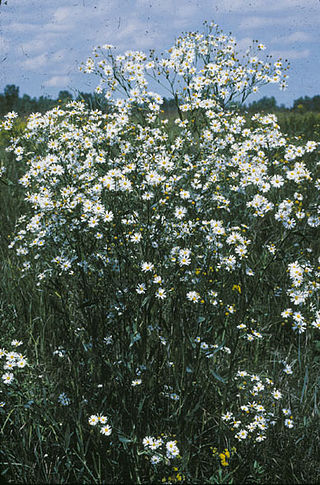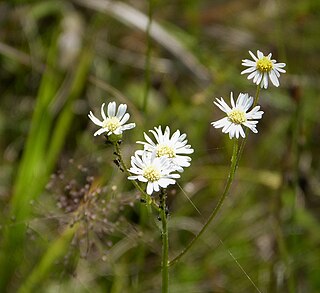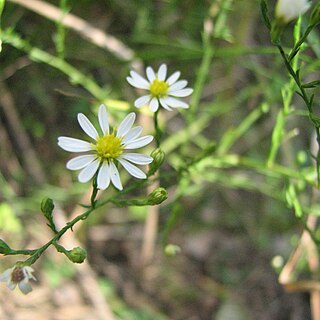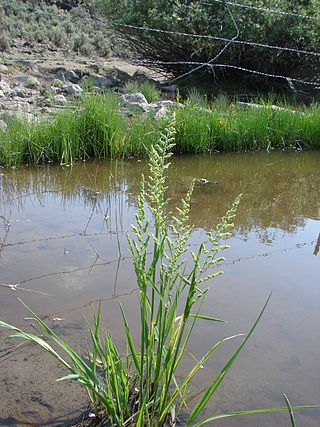
Boltonia asteroides, the white doll's daisy, false chamomile, or false aster, is a species of plant native to the United States and Canada. It is found primarily in the Mississippi Valley and Great Plains from Saskatchewan south to Texas and Florida, with isolated populations in the eastern United States. Reports of the species in New England, New York, and the Pacific Northwest appear to be introductions.

Boltonia diffusa, the smallhead doll's daisy, is a North American species of plants in the family Asteraceae. It native to the United States, primarily the states along the Gulf of Mexico from Texas to Florida plus the lower Mississippi Valley from Louisiana to Illinois. There additional populations in the eastern United States as far north as Virginia.

Boltonia is a genus of plants in the family Asteraceae native primarily to North America with one species in eastern Asia.

Symphyotrichum depauperatum, commonly known as serpentine aster or starved aster, is a rare species in the family Asteraceae adapted to serpentine barrens, an ecosystem with a high concentration of toxic metals in the soil. It has been found in Pennsylvania, Maryland, and on some diabase glades in North Carolina. It grows to 50 centimeters and has white ray florets surrounding a center of yellow disk florets.

Beckmannia syzigachne, the American sloughgrass, or slough grass, is an annual or short-lived perennial bunchgrass in the grass family, Poaceae, found in shallow marshes or sloughs.

Ageratina luciae-brauniae is a species of flowering plant in the family Asteraceae known by the common names Lucy Braun's snakeroot and rockhouse white snakeroot. It is native to the eastern United States, where it is limited to the Cumberland Plateau of Kentucky and Tennessee. It may also occur in South Carolina but these reports are unconfirmed.
Malaxis bayardii, or Bayard's adder's-mouth orchid, is a species of orchid native to northeastern North America. It is found from Massachusetts to North Carolina, with isolated populations in Ohio and Nova Scotia. There are historical reports of the plant formerly growing in Vermont and New Jersey, but it seems to have been extirpated in those two states It grows in dry, open woods and pine barrens at elevations of less than 600 m.
Bidens eatonii is a North American species of flowering plant in the family Asteraceae. It is native to eastern Canada and the northeastern United States.
Bidens heterodoxa, the Connecticut beggarticks, is a North American species of flowering plant in the family Asteraceae. It is native to eastern Canada and the northeastern United States (Connecticut).

Bidens hyperborea is a coastal species of flowering plant in the family Asteraceae. It grows along the coasts of Hudson Bay, the Arctic Ocean, and the North Atlantic Ocean in eastern Canada and the northeastern United States.
Boltonia apalachicolensis, common name Apalachicola doll's-daisy, is a North American species of plants in the family Asteraceae. It is found in the "panhandle" region of northwestern Florida, and has been found in south Louisiana, and Mississippi in the United States.
Boltonia montana, the mountain doll's daisy, is a North American species of plants in the family Asteraceae. It is found only in the east-central part of the United States, in the states of New Jersey, Pennsylvania, and Virginia.
Rubus aculifer, the thorny dewberry, is a rare North American species of flowering plant in the rose family.
Rubus adenocaulis is a rare North American species of flowering plant in the rose family. It has been found only in the Province of Nova Scotia in the eastern Canada.
Rubus tholiformis is a rare North American species of flowering plant in the rose family. It has been found only in eastern Canada and the northeastern United States.
Rubus adjacens, the peaty dewberry, is a rare North American species of flowering plant in the rose family. It is native to eastern Canada and the northeastern and east-central United States (Maine, New Hampshire, Vermont, Massachusetts, New York, Pennsylvania, Maryland.
Rubus paludivagusis a rare North American species of flowering plant in the rose family. It has been found only on the edges of cranberry bogs on Cape Cod. This is in the Commonwealth (State) of Massachusetts, in the northeastern United States.
Rubus defectionis, the Eclipse blackberry, is a rare North American species of flowering plant in the rose family. It grows in only a few locations in the east-central United States.
Rubus kennedyanus is a rare North American species of brambles in the rose family. It is found in eastern Canada and in the north-central United States.
Rubus pernagaeus is a rare North American species of flowering plant in the rose family. It has been found only in the state of Virginia in the eastern United States.





